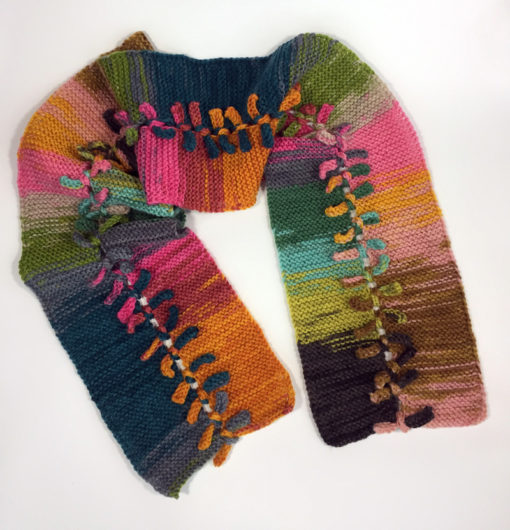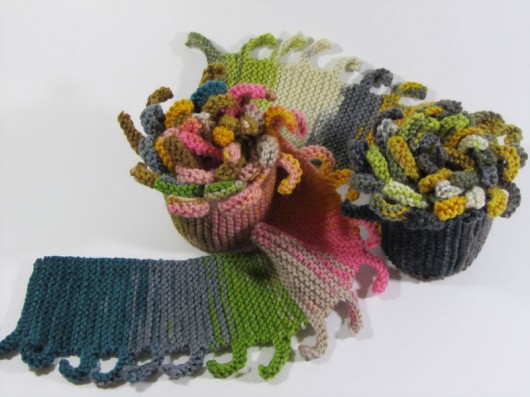This is Helene Rush’s Bowties Scarf, knit in Classic Elite’s multi-colored Liberty Wool. It’s a superwash worsted. Two skeins of two separate colorways create this interesting piece. In fact, if you knit a third section in another colorway, you’d end up able to mix-and-match for additional looks. That’s what a new knitting friend of mine is planning after meeting my Bowties in person.
This photo explains.
These aren’t knitted centipedes having a rumble. These are the individual halves of the scarf. Here are the halves curled up into flower blooms.
Set out in these photos my guess is that you’ve figured out just how easy a knit this garter stitch cutie is.
Let’s put it back together, matching up each tab in one strip with its twin tab in the other strip. I’ve found that a square knot works best.
Here’s one I made in two different colorways about five years ago. It’s such a good knitting idea, don’t you think? And Liberty Wool really makes it pop. But you could knit it out of any interesting color-changing yarn. Or even out of two (or one) solid colors. Or try a color-changing yarn on one side and a solid on the other. Check out the Ravelry project pages to see what the knitting universe has come up with.
I recently came into a cache of Liberty Wool multi when a favorite shop closed. So unfortunate. But the shop’s owner deeply discounted her yarns and I drank deeply at the well.
Meet Molly.
You’ve met Good Golly Miss Molly on my blog once before. We marveled at how the heck this four-row pattern ends up looking so cool. Some have likely felt a bit miffed at paying six dollars for a four-row pattern. (Actually, I have the Classic Elite booklet that includes Molly so my investment was much less per pattern-row.) But, really, could any of us have figured out how to make this happen out of a piece of what’s basically colorful fat string? Susan Mills is the knitting world genius who figured it out.
I enjoy the way the ruffles can be wound up. In fact, it’s a great way to store Molly.
Molly’s two halves on either side of the center ridges are not the same. One side is squared up near the ridge and the other one is pointy. If the scarf is folded along its top spine, the flopped-over (then-public) side will match the bottom half. It’s hard to explain but very easy to knit. And by the time you’re done with this scarf you will be a short-row wiz.
Here’s my best hint to free yourself from consulting the pattern except for a few repeats. It works as long as you can easily count ridges to be sure you don’t end up with a fat (or skinny) ruffle. Knit a row 1 if you see two ridges as you start the row. Knit a row 3 if you see 4 ridges. Others have also emphasized that it’s important to mark the “right hand side” of the work. By that, they mean, the right (as you look at your work) rather than the left side. I did that. But it’s not needed if you just count the ridges as you start a row.
We knitters owe so much to Classic Elite for its great yarns and wonderful patterns. I am already mourning that it “will be closing its doors in the very near future.” “Say it ain’t so, Joe.” But it’s so.












